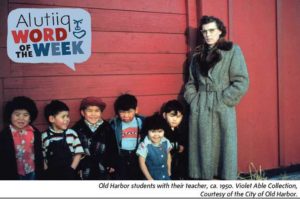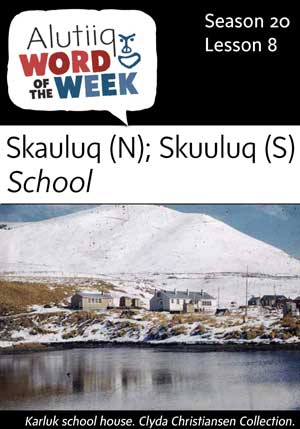 Teacher– Litnauwista, Uciitilaq
Teacher– Litnauwista, Uciitilaq
Litnauwistarpet asirtuq. – Our teacher is good.
Western-style teachers became part of the Kodiak landscape in the late eighteenth century, soon after the arrival of Russian fur traders. Although Alutiiq adults taught their children the skills they needed for life in the Alutiiq world, a small number of boys began to study the Russian language, mathematics, and navigation at a secular school founded by Gregorii Shelikof in 1786. In 1794, when the first Orthodox mission arrived in Kodiak, clergy members took over the school, acting as its teachers and administrators.
The number of Kodiak schools and teachers proliferated in the late nineteenth and early twentieth century, after the purchase of Alaska by the United States. In the American era, missionaries set up orphanages with schools in places like Woody Island and Ouzinkie, and the Bureau of Education began establishing community schools.
These government schools were the precursors of modern public schools, although most did not offer high school classes. Students who wanted to earn a diploma had to leave home for boarding schools in places like Sitka, Alaska, and Salem, Oregon. Boarding schools were damaging to many students. They were far from home, forcing years of isolation from family members, separation from community events and cultural practices, and increasing dropout rates. One Alutiiq Elder recalls how his father died while he was at boarding school and the pain of not being able to return home.
In 1972, twenty-seven Alaska Native students sued the State of Alaska for failing to provide high schools in their communities. They argued that the state was denying them fair access to an education, as guaranteed by Alaska’s constitution, and that this failure was in violation of the United States Constitution’s prohibition against discrimination. The Alaska Supreme Court agreed. This decision began a period of school construction in rural communities and created the schools that children in Alutiiq villages attend today. Although some students still opt for boarding school, most are educated in their own communities where their families can also be their teachers.
Source: Alutiiq Museum








